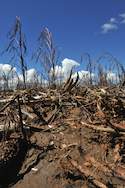Hard Work Undone

It is the morning after another heavy rain. The last rivulets of water still trickle their way over the sodden earth and head for lower ground, leaving the sand twinkling back in delight at the smouldering blue sky that still hangs with the occasional bloated cumulus cloud.
The torrent has sifted up a layer of fine sand and spread it across the bottom edge of the field, smoothing it over, then chiselling its veneer with irregular herringbone grooves. In the middle distance, bony sandstone outcrops punch up through the grassy foothills of the eastern Free State’s Rooiberge like a bare-knuckled fighter.
The sun in its zenith throws their shapes into frowning contrast – bottomless shadows recessed next to the eye-watering sheen where the sun ignites the glistening rock. But too much of a good thing can leave one decidedly the worse for wear. ‘We had 80 millimetres in the past 24 hours,’ says farmer Jan Scheepers, scanning the damage from the road verge, the waist-high blackjacks trying to lodge their grappling hooks into his khaki-grey fleece top.
He had been preparing the field for another season of wheat before a previous bout of rain stormed through and undid all the work. He had kept it clear of weeds to conserve the moisture in the soil, a must to give the rainfed crops a boost through dry spells; he had dug furrows along the contour at the top of the field to catch water running off the nearby hills and steer it away from the raw, ploughed soil.
But earlier in the month, in what should usually be the end of the dry winter season, the Ficksburg area had 120 millimetres of rainfall in 24 hours. ‘It washed away those ditches and filled it up with sand. It was too wet to fix it. Before I could do anything, it rained again and now we’ve got this great erosion damage in these fields.’ A wet summer has wrought havoc on the 2011 bean crop, running up a loss of about R5 million.
Bizarre Conditions and Disaster
It has been a bizarre year, weather-wise, a La Niña season, according to the South African Weather Service. This is the other side of the El Niño Southern Oscillation, which tick-tocks between drier conditions across southern Africa on the El Niño side of the cycle, and then flushes through a few years later with wetter La Niña conditions.
Since about December 2010, summer-rainfall parts of the country have had much higher than average rainfall, with eight of the nine provinces declared disaster areas in January 2011 and over a hundred people killed by flood waters. In 2010, the area had 1 100 millimetres of rain in a place where the annual average is about 800 millimetres.
What aggravated the inundations was that they came after a witheringly dry winter. ‘We aren’t a winter rainfall area, but we usually get a little rain in winter. We had nothing,’ Jan explains earlier, sitting at an expansive square desk in the farm’s office – the command centre of his six-farm operation.
Behind him is a trophy, perched on a filing cabinet in the corner. The words engraved into its plaque compete with reflections of the room, picked up in its high-sheen finish: 2010 Toyota Young Farmer of the Year Jan Scheepers. Above the plaque, metal leaves unfurl from what looks like an angular wheat kernel.
‘There’s a guy in Ficksburg whose grandfather did rainfall calculations for many years, and he said it was the driest winter in a hundred years. ‘But it followed a particularly opulent summer, so the grass was tall and big,’ says Jan, his voice dry and factual. ‘We battled fires, the worst we ever had. And then it started raining, and once it started raining, we had the wettest summer, I think, in 102 years.’
Losing Millions
Jan knows how to work his land for normal conditions, preserving soil moisture and the like. His main crop, maize, did okay – ‘maize has a strong root system and they use a lot of water’ – but for wheat and beans, this season has been pretty devastating. Beans do not need that much water, so a season of heavy rain has left their feet sodden in the water- choked soil.
‘Big, big patches died. I lost about 50% of my whole crop, 50 to 60%.’ He whips a calculator from his breast pocket, and taps in some numbers with fingers built more for driving combine harvesters than wafer-thin electronics. ‘Five million rand. That’s what I’ve lost on my bean crop.’ The calculator goes back in the pocket. He has been trying to get the ripe beans in off the lands but this rain is not helping.
The cement floor of the sprawling warehouse on his main property, Liberhof, has been turned into a field of sugar beans deep enough to bury a shoe. Usually, when the bean plants are cut, they are left to dry in the field until the seeds are hard as billiards. Then they are brought in, shaken free of the stubble and dried leaves in a sorting machine, and finally bagged.
But, with this much moisture around, the beans will not dry out there in the field. They discolour or, worse, rot. So it is best to bring them in and sweep them into a layer under the tin roof and wait out the weather.
By Leonie Joubert